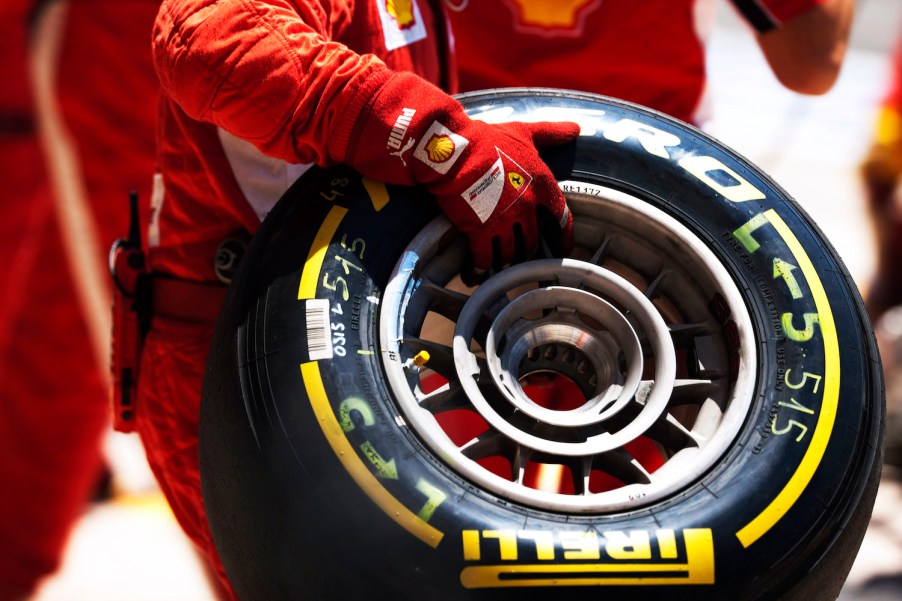
Tire Speed Rating Chart
Driving fast puts stress on your tires. At a high enough speed, any tire will blow out. Therefore, tire manufacturers rate each model of tire for a top speed. Knowing your speed rating is important for proper maintenance. Luckily, every manufacturer stamps a tire’s top speed at the end of the tire size on the sidewall. Unluckily, the speed rating is a code, a letter representing a given number of miles per hour. Use our handy speed rating chart to find out the top speed of your tires.
How To Find Your Tires’ Speed Rating

First, locate your tire size stamped into each tire’s sidewall. It should be three groupings of letters and numbers, separated by two slashes. Your tire speed rating will be the final letter in your tire size. For example:
- A tire with a size of “275/55R20/113T” has a speed rating of T
- If a tire reads “225/65R17/102H” it has a speed rating of H
- When a tire is stamped “205/65R15/94V,” it has a speed rating of V
Once you know your tire’s speed rating letter, you can look it up on our tire speed rating chart.
Tire Speed Rating Chart

| Code | km/h | mph | Code | km/h | mph | |
|---|---|---|---|---|---|---|
| A1 | 5 | 3 | L | 120 | 75 | |
| A2 | 10 | 6 | M | 130 | 81 | |
| A3 | 15 | 9 | N | 140 | 87 | |
| A4 | 20 | 12 | P | 150 | 94 | |
| A5 | 25 | 16 | Q | 160 | 100 | |
| A6 | 30 | 19 | R | 170 | 106 | |
| A7 | 35 | 22 | S | 180 | 112 | |
| A8 | 40 | 25 | T | 190 | 118 | |
| B | 50 | 31 | U | 200 | 124 | |
| C | 60 | 37 | H | 210 | 130 | |
| D | 65 | 40 | V | 240 | 149 | |
| E | 70 | 43 | Z | over 240 | over 149 | |
| F | 80 | 50 | W | 270 | 168 | |
| G | 90 | 56 | (W) | over 270 | over 168 | |
| J | 100 | 62 | Y | 300 | 186 | |
| K | 110 | 68 | (Y) | over 300 | over 186 |
The History of Tire Speed Rating Codes

Tire speed ratings have changed a lot over the years. Once, all early tires were bias-ply tires: the steel bands that gave these tires structure overlapped at a 45-degree angle for maximum strength. But bias-ply construction limits a tire’s top speed. Then, engineers developed more reliable materials and radial-ply tires became more popular. In radial-ply tires, the structural steel bands run perpendicular to the direction of travel, as if extending from the wheel’s radius. As a result, these tires have a much higher top speed.
Until 1991, a tire’s speed rating included its bias-ply (b) or radial (r) designation. Thus, the speed ratings appeared before the tire’s construction type, just after their aspect ratio. For example:
- “225/65R17/102H” would have been “225/65HR17/102”
- “205/65R15/94V” would have been “205/65VR15/94”
Before 1991, a speed rating chart would have read as follows: SR (112 mph), HR (130 mph) and VR (in excess of 130 mph). And manufacturers gave any tire with a speed rating over 186 mph the “Y” designation.
In the future, tire technology will continue to improve, and new speed rating designations will be added to the speed rating chart. When Bugatti attempted the production car speed record, the French manufacturer contacted Michellin for cutting-edge, 300 mph tires. As a result, Michelin built carbon fiber belted high-speed tires, and Bugatti set a world speed record.
Changing Your Tire Speed Rating

When a manufacturer designs a tire with a speed rating of 130 mph, that tire will suffer less sidewall flex at 65 mph than a tire rated for 112 mph. As a result, the performance tire with the higher speed rating will generate less heat and may even last longer. It is not a good idea to select a lesser tire, from further up the speed rating chart. In some countries, it is illegal to downgrade your tire speed rating from the tires your car had new.
But a tire with a higher speed rating may make for a stiffer ride. Of course, you can always safely upgrade your tire to a performance tire with a higher speed rating, but do your research to see how the new tires will affect your ride quality.



